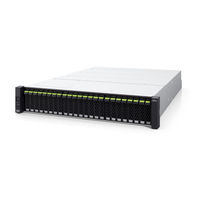Fujitsu ETERNUS DX500 S5 Manuals
Manuals and User Guides for Fujitsu ETERNUS DX500 S5. We have 4 Fujitsu ETERNUS DX500 S5 manuals available for free PDF download: Design Manual, Configuration Manual, Operation Manual (Basic
Fujitsu ETERNUS DX500 S5 Design Manual (335 pages)
Hybrid
Table of Contents
-
1 Overview
20 -
-
-
-
RAID Group37
-
Volume40
-
Hot Spare42
-
Figure44
-
-
Rebuild51
-
-
-
-
-
Remote Support103
-
Power Control105
-
-
Backup (SAN)108
-
-
3 SAN Functions
128-
-
Stable Operation139
-
Data Migration145
-
-
Vmware Linkage150
-
-
4 NAS Functions
160-
-
NAS File Systems164
-
NAS Volume166
-
Block Size169
-
Data Encryption171
-
User Management173
-
File Sharing184
-
CIFS Operation186
-
NFS Operation188
-
-
Home Directories189
-
Quota190
-
Snapshot192
-
Backup195
-
Audit Log196
-
-
-
LAN Connection203
-
SAN Connection210
-
Host Interface210
-
Access Method213
-
-
-
NAS Connection219
-
Redundant Method222
-
Ftp/Fxp231
-
-
-
Eternus Dx60 S5246
-
Eternus Dx900 S5255
-
Controllers257
-
Component264
-
-
Drive Enclosure266
-
Component270
-
-
System Memory279
-
Extreme Cache282
-
Host Interface284
-
Unified License287
-
Drive Enclosure287
-
Drive289
Advertisement
Fujitsu ETERNUS DX500 S5 Configuration Manual (259 pages)
Hybrid Storage Systems
Table of Contents
-
-
-
-
-
Powering on67
-
Powering on70
-
-
-
-
-
Add Host Groups148
-
-
-
SNMP Trap Setup161
-
E-Mail Setup167
-
Syslog Setup169
-
-
Audit Log Setup174
-
-
SNMP Trap Test176
-
Send Test E-Mail177
-
-
-
-
Green193
-
-
Vmware Linkage196
-
Security202
-
-
Component Names
204-
-
-
Front216
-
Rear219
-
Figure 64 PFM241
-
-
Drive Enclosure243
-
Fujitsu ETERNUS DX500 S5 Operation Manual (Basic (135 pages)
Hybrid Storage Systems
Table of Contents
-
-
-
Powering on18
-
Powering off21
-
-
-
-
-
Front95
-
Rear98
-
Figure 48 PFM120
-
-
Drive Enclosure122
-
Advertisement
Fujitsu ETERNUS DX500 S5 Configuration Manual (75 pages)
All-Flash Arrays, Hybrid Storage Systems, Disk Storage Systems, Power Synchronized Unit
Table of Contents
-
Overview20
-
Features21
-
Components23
-
Installation32
-
Preparation32
Advertisement
Related Products
- Fujitsu Eternus DX500 S3
- Fujitsu ETERNUS DX500 S4
- Fujitsu ETERNUS DX500 S4/DX600 S4
- Fujitsu ETERNUS DX500 S3/DX600 S3
- Fujitsu Eternus DX80 S2
- Fujitsu Eternus DX90 S2
- Fujitsu Eternus DX200F
- FUJITSU ETERNUS DX S2, ETERNUS DX S3, ETERNUS DX S4, ETERNUS AF
- Fujitsu ETERNUS DX100 S5
- Fujitsu ETERNUS DX600 S5



